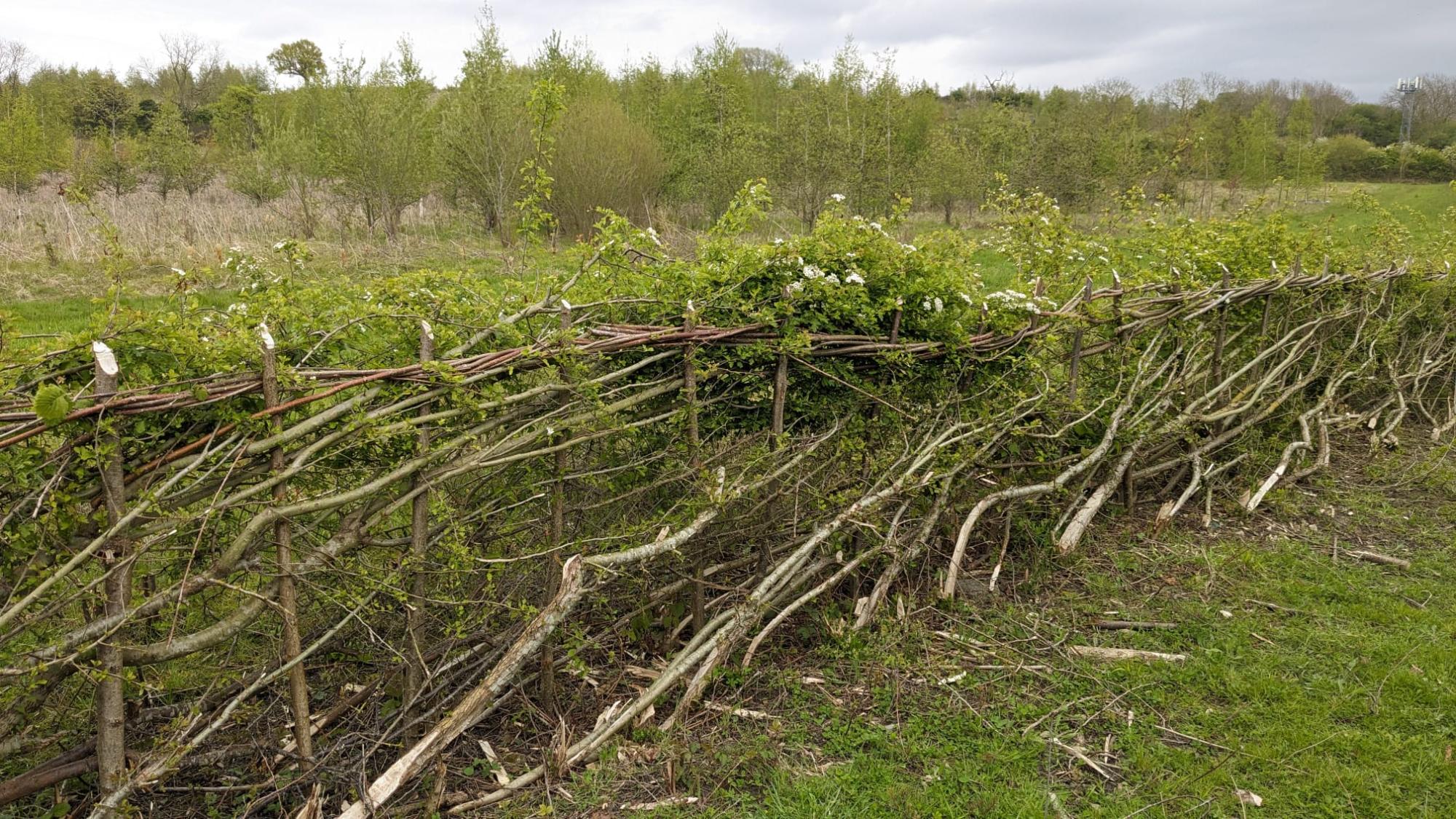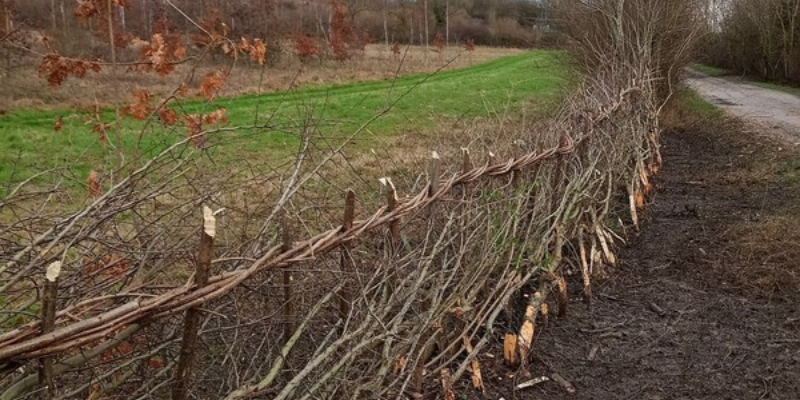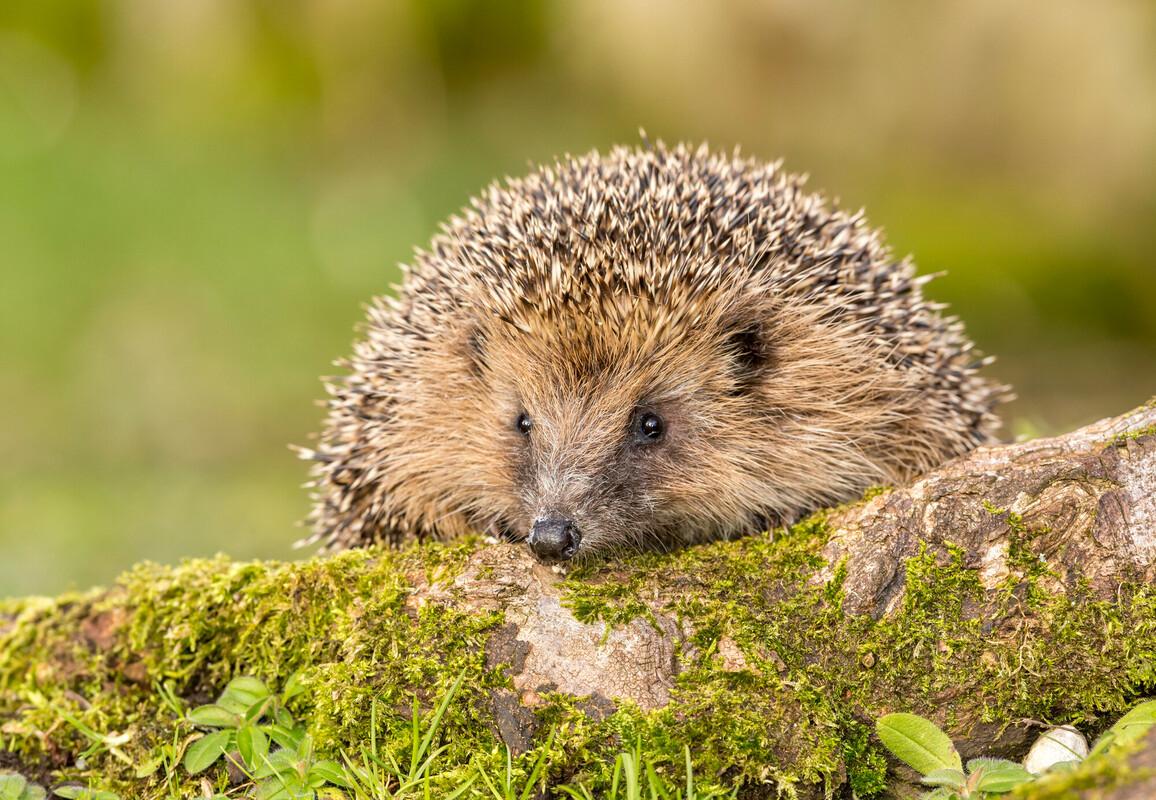
Hedgelaying: Protecting heritage
Hedgerows cover half a million miles throughout the UK, the modest hedge is a haven for wildlife providing food, shelter, and corridors through which wildlife can travel. Historically, hedges were created during the process of Enclosure which transformed the English landscape throughout the Middle Ages. To this day, hedges serve as a demarcation of land, and bordering fields are often grazed by cattle or sheep.

Managing hedgerows
There are several management practices undertaken to maintain hedgerows. Over-management can lead to the degradation of a hedge, so it is vital that hedgerows are managed with longevity in mind. So, the question arises: how is best to manage a hedge?
One management practice known as ‘flailing’ involves a tractor mounted flail mower that trims the tops and sides. Whilst a flailed hedge looks neat, it can create an open structure which ultimately encourages a hollow base, allowing livestock to push through and providing little shelter for wildlife.
Though flailing doesn’t always equate to the decline of a hedge’s health, the frequency of which the task is carried out can cause damage, with some people flailing twice a year. Cutting at this frequency, or cutting too low, doesn’t allow the hedge to regenerate properly and causes a top-heavy hedge. At the other extreme, neglecting a hedge will allow it to become tall and overgrown, eventually creating a line of trees. This is where hedgelaying comes in.
Hedgelaying
Hedgelaying is a countryside craft and a traditional form of management. It has been practiced for hundreds of years and historically used to create a barrier to livestock. It encourages the sympathetic management of hedgerows for wildlife and landscape.
It is completed in winter when trees are dormant. The process involves cutting individual stems, known as ‘pleaches’, almost all the way through and laying the cut stems at a 45-degree angle. The remaining ‘heel’ of the stem is cut off so that the hedge can re-grow from the base and create healthy new foliage. Finally, the hedge is secured with stakes, weaving the laid stems between them. In some styles, hazel binders are used along the top for aesthetic purposes and for extra stability. The hedge can be re-layed when the regrowth is old enough and is maintained every 8-10 years.
There are more than 30 styles of hedgelaying recorded in the UK. Nine of the most prominent styles are: Derbyshire, Devon, Dorset, Lancashire & Westmorland, Midland Bullock, North Somerset, South of England, Welsh Border and Yorkshire. Each style was curated to meet differing regional needs, considering the area's climate, different farming practices, and the types of trees and shrubs growing in that region.

Hedgelaying in the Forest
Being situated in The Midlands, The Heart of England Forest adheres to the local Midland Bullock style. This style follows the above method, with the addition of a roped hazel binder running along the top. The binder creates an ornate structure and helps secure the hedge. Traditionally, a farmer would plough the field on the smoother side of the hedge and graze cattle on the thick, jagged side, which is created by the brushy tops of the laid stems. Cattle would then be less inclined to push against the rough, thorny brush, stopping them from damaging the hedge and escaping. Once the hedge is laid, woven and bound, the side with the brush is trimmed to form a box shape.
Traditionally this process would be carried out with one tool; the billhook. Similarly to styles of hedgelaying, there are different patterns of billhook, and each design is changeable based on the region of origin. There are eleven main types of billhooks, which roughly follow the subsequent pattern: a curved blade made from steel, with a bevelled edge. Some patterns call for a double handed grip, whilst others are single handed.
Hedgelaying preserves the past and protects the future.

Combating hedgerow decline
The practice of hedgelaying is vitally important when upholding land management traditions. After the second world war, hedgelaying was in decline. The availability of labour, the introduction of machines, and changes in agriculture meant that the craft was all but forgotten. By the 1960s, the situation was even more bleak; many hedges were grubbed out (dug out and removed) to make expansive fields that could be better managed by larger machinery. In 1978, realising the centuries-old art was at risk of being lost, three hedgelayers (Fred Whitefoot, Clive Matthew and Valerie Greaves) set up a national society, ensuring the skills of hedgelaying persevered. Today competitions are organised nationally, and though modernity has snuck in with the increasing use of chainsaws supplementing the traditional billhook, hedgelaying is celebrated.
Benefits to wildlife
In comparison to other methods of hedge management, hedgelaying arguably offers the biggest benefits to wildlife. It is the only hedgerow maintenance practice which promotes regrowth from ground level, thus ensuring the health and longevity of the hedgerow. The regrowth offers a dense refuge for a variety of species, including hedgehogs, bank voles, brown hairstreak butterflies and yellowhammers. Sympathetic management allows blossom and berries to form, providing nectar and pollen for pollinators, and a food source for hedgerow birds. The brushy, thick layer also creates an impenetrable barrier to contain livestock; a great balance between habitat and functionality.
The beauty of hedgelaying also lies in the fact it works in conjunction with other woodland practices such as coppicing, using coppice products to stabilise a laid hedge. The marrying of these two practices reinforces the linear nature of sustainable woodland management; one allowing the other. The connection of these two traditional forest crafts perpetuates the human desire to protect our heritage, whilst allowing nature to flourish.

How can you help?
You can help create and conserve a huge broadleaf forest, that will be protected and secured for generations to come.
Please donate £5 a month, or more if you can, and we promise to keep up you to date with the latest news from the Forest, and how you are helping it thrive.



